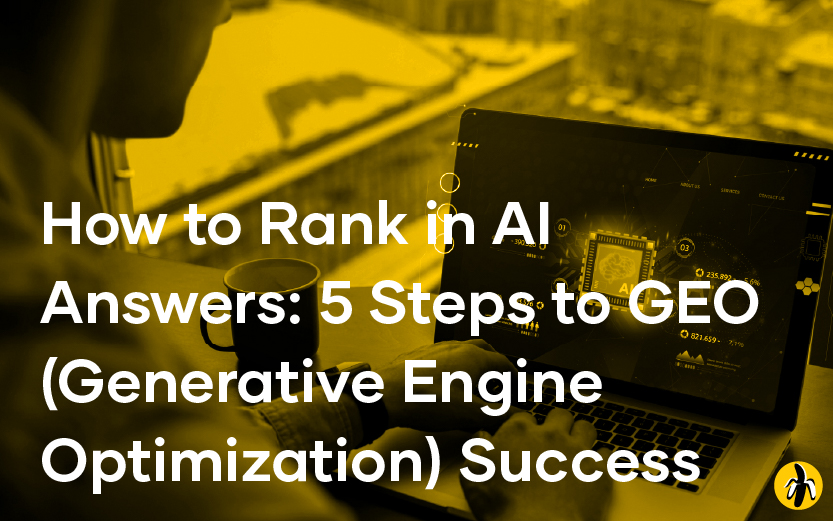Search Has Changed Forever
Here is a quick test: type your business name into ChatGPT. What shows up? If the answer is nothing or just a vague mention with no details about you, it is time to rethink your content strategy.
How Do We Format Content So AI Picks It Up?
Generative Engine Optimization (GEO) is not replacing SEO. It is adding a new layer of visibility. Where SEO helps you rank in Google, GEO ensures your content is structured so AI tools like ChatGPT, Google SGE, and Perplexity choose your answer over others.

AI models are trained to surface content that is helpful, clear, and complete. GEO increases the chances that your content is selected and recommended in AI-generated answers.
The 5 Steps to Rank in AI Answers
Step 1: Start with Long-Tail Prompts
Think like your customer. Instead of targeting short phrases such as “accountant Sydney,” target natural questions such as “best tax-saving strategies for small business owners in Sydney.”
People type into AI tools the same way they speak, by asking complete questions. Some examples include:
- “What’s the best way to market my coaching business in 2025?”
- “How can I attract more clients to my fitness studio?”
- “Best ways to promote a naturopath clinic online?”
- “What are the best low-cost marketing tips for a physiotherapy clinic in Sydney?”
Short keywords are no longer enough. Clear, natural, longer prompts are more effective for GEO.
Step 2: Use the Above Questions as Subheadings and Answer Them
Update your content by replacing generic headings with natural, question-style subheadings. For example:
- Instead of “Our Services” → “How Can We Help Small Businesses Save on Taxes?”
Step 3: Give the Complete Answer
AI prefers content that is self-contained. Avoid teaser-style answers. Do not send readers away too early. Provide the complete solution, then add links for more depth.
Example:
Poor teaser answer:
Getting more customers takes strategy. Click here to learn the secrets to coffee shop marketing.
Stronger complete answer:
To attract more customers to your coffee shop, make it stand out in your community. Offer a “first cup free” deal for new customers, use a large chalkboard outside with a clever coffee pun of the day to grab attention, and partner with a local bakery to add exclusive menu items. This approach creates curiosity, word of mouth, and repeat visits.
Step 4: Add AI-Friendly Summary Boxes
Summaries help AI and human readers quickly capture the value of your content. Add a “Here is what you will learn” section at the beginning or a TL;DR at the end. Keep paragraphs short and scannable.
TL;DR: Quick Summary
- Use long-tail, conversational prompts as your keywords.
- Turn these prompts into subheadings and provide full answers.
- Deliver complete solutions instead of teaser content.
- Add summary sections for easier scanning and AI extraction.
- Strengthen your credibility with testimonials, data, and trusted sources.

Step 5: Add Trust Signals
Include testimonials, client stories, links to credible references, and data. Content that demonstrates authority and trustworthiness ranks higher in AI answers.
Why This Works
By writing content in the way people prompt AI, your answers become the natural choice for these systems to display. This leads to more visibility, more clicks, and more authority for your brand.
Futureproof Your Content
Your competitors will soon adapt to GEO. Stay ahead by applying these five steps to every piece of content you create. This will help your business show up in AI-driven answers across multiple platforms.
Need help? That is exactly what we do. Let us get your content found by both humans and AI. Join our AI Masterclass.
Follow us on Instagram | Connect with us on LinkedIn | Contact Us
How Is GEO Different From SEO?
| Feature | Traditional SEO | GEO (Generative SEO) |
|---|---|---|
| Focus | Google and Bing | AI Tools such as ChatGPT |
| Keywords | Short keywords | Long prompts and questions |
| Structure | H1, H2, metadata | Conversational subheadings |
| Goal | Search visibility | Answer selection by AI models |
| Ranking Factors | Backlinks and keywords | Helpfulness, clarity, and authority |
Why GEO Matters Now
AI tools such as ChatGPT, Perplexity, and SGE are already the first stop for millions of daily searches. The rule is simple: provide value. AI rewards content that is useful, complete, and human-focused.
FAQ
What is GEO (Generative Engine Optimisation)?
GEO is a strategy that helps your brand show up in AI-generated answers. It involves writing with prompt-style subheadings, offering full solutions, and formatting content for easy scanning.
How is GEO different from traditional SEO?
SEO focuses on ranking in search engines. GEO focuses on writing content in a way that AI models can extract and present as helpful answers.
How can I make my blog content more AI-friendly?
Use long-tail prompts as headers, structure content clearly, add summaries and FAQs, and avoid keyword stuffing. Ask: “Would AI select this as a complete, helpful answer?”

Does GEO work for all industries?
Yes. Coaches, clinics, consultants, and creatives all benefit from GEO. If your audience uses AI to search, you can improve visibility with this method.
Can I apply GEO to existing content?
Yes. You can optimize past blog posts by rewriting subheadings into questions, expanding answers, and adding summaries and FAQs.
